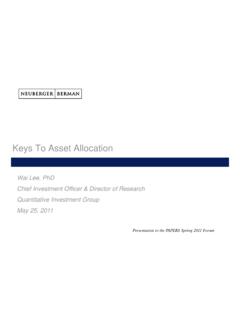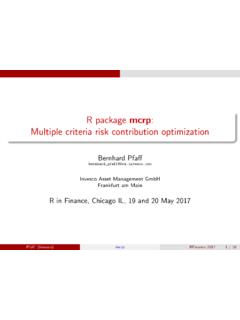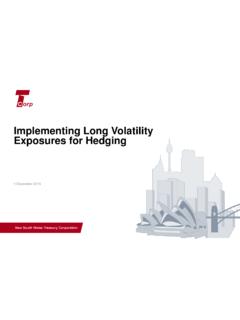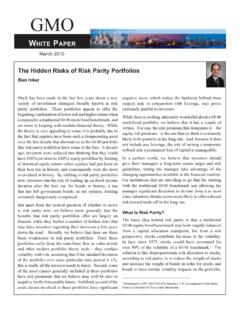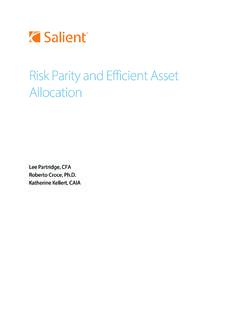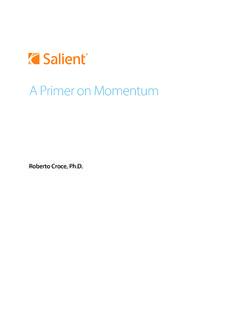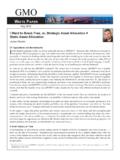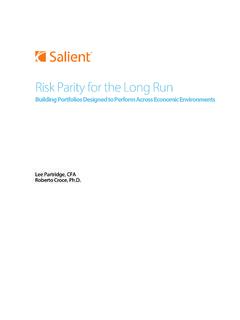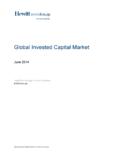Transcription of QMA Whitpaper-A Case For Active Asset Allocation 4-14
1 April 2014 Another entry in the QMA Turbulent Teens series of white papersA case for Active Asset AllocationEd KeonPortfolio ManagerExecutive SummaryWe think that Active Asset Allocation , a strategy that rotates among Asset classes based on expectations of return and risk, can offer some investors a more attractive overall portfolio option than a static or formulaic approach. In our view, the major problem faced by Asset allocators is that the Asset class with the highest historical real return, equities, has an annoying tendency to provide highly negative returns periodically. We suggest that a strategy which ypgygpygggyfocuses on trying to avoid big losses while harvesting the high average real returns of risky assets might provide a better combination of return and risk than a static 60% stocks, 40% bonds portfolio, and we present some evidence to support this in Asset Allocation Strategies Over the Past Two DecadesOrigins of Asset Allocation : 60/40 Investors have long understood the importance of Asset Allocation in constructing portfolios with attractive expected returns at acceptable levels of risk.
2 For many years, the standard approach was to create a diversified portfolio of traditional assets, consisting of 60% stocks, 40% bonds (henceforth 60/40), which seemed to offer a reasonable combination of the higher returns typical of stocks with the lower volatility typical of the past two decades, however, investors have experimented with different approaches, sometimes to extremes. During the great bull market of the 1990s, a paper published in the gg,pppFinancial Analysts Journal asked, Why Not 100% Equities? 1 The bear market of 2000 2002 answered that Stocks and BondsThe bear market to start the 21st century, in fact, spurred many changes to thinking about Asset Allocation among institutional investors.
3 Pioneers like the Yale endowment fund had already reached far beyond stocks and bonds to invest in timber, hedge funds, commodities, and other alternati e Asset lasses to both add di ersifi ation and enhan e ret rns of theirand other alternative Asset classes to both add diversification and enhance returns of their portfolios. Their success during the 2000 2002 bear market attracted more institutions to alternative assets. Prior to the bear market, some pension funds had begun structuring their expected return stream to better match their forecasted liabilities. Their success during the bear market inspired others to follow their lead. These concepts were new 15 to 20 years ago, but have become mainstream ParityFor more information, please contact:Stephen BrundageProduct SpecialistQuantitative Management AssociateshThe second bear market of the 21st century, in 2008 2009, further stimulated efforts to find alternatives to the 60/40 portfolio.
4 Advocates of what became known as risk parity argued that a levered portfolio of lower volatility assets like bonds could provide equal or higher expected returns with lower risk compared to stocks. Although this idea quickly gained traction with investors and attracted substantial assets in the wake of the financial crisis, some have wondered whether the impressive backtestand early live results were largely driven by the 30-year bull market for bonds from 1981 the jury is still out, some risk 12 Gateway Center, , NJ 07102 , Richard H., and Williamson, J. Peter, College and University Endowment Funds: Why Not 100% Equities? The Journal of Portfolio ManagementFall 1994, Vol.
5 21, No. 1, pp. , Robert M., Bianchi, Stephen W., Goldberg, Lisa R., Will My Risk parity Strategy Outperform? Working paper #2012-01, March 27, 2012parity strategies did struggle to keep up with 60/40 during the strong equity market and weak bond market in 2012 2013. Enhancements Within EquityMost Approaches Rely On Formulas Derived from HistoryEach of the Asset Allocation strategies designed to improve upon the 60/40 portfolio has its pros and cons itsSeptember 2012 Enhancements Within EquityMuch work has also been done over the past few decades to improve Asset Allocation within the equity portion of the 60/40 portfolio. The first step was to enhance diversification relative to an S&P 500 portfolio by adding small cap, tilting towards value, and adding international developed and emerging markets exposure.
6 This more diversified approach to equity investing has become fairlyupon the 60/40 portfolio has its pros and cons, its advocates and detractors. Most of the new approaches have certain things in common. They examine the history of investment results and seek to identify a strategy that would have provided an acceptable or superior average result. The resultant strategies tend to be relatively static or formulaic. We Think An Active Asset Allocation Strategy Can diversified approach to equity investing has become fairly common today. Smart Beta More recently, some investors have found that, historically at least, equity portfolios that weighted stocks differently than the standard market capitalization approach could improve the return/risk equation.
7 Nowadays these idbldhdhbiOffer An Attractive AlternativeThe Active Asset Allocation AlternativeAnother approach might be to rotate into and out of assets without a pre-set formula, in pursuit of higher returns at acceptable levels of risk. These sorts of strategies are referred to as global unconstrained, global macro, or global tactical Asset Allocation (GTAA) Each of these terms mightstrategies tend to be lumped together under the rubric smart beta. The weighting schemes might favor stocks with lower volatility, higher sales or dividends, lower valuations, etc. As with risk parity , these ideas are supported by impressive backtests and solid early real-world results that have generated a significant following.
8 As with all these innovations, time will tell which will generate lasting value and which are time-period specific. tactical Asset Allocation (GTAA). Each of these terms might mean somewhat different things to different investors, but in general the idea is to dynamically manage a portfolio to achieve a solid combination of expected Asset returns and risks . 60/40 vs. a Crystal BallThe hypothetical attractiveness of such a portfolio might be dhddadw c aet epe od spec Date FundsFor individual investors, the biggest change in Asset Allocation over the past couple of decades has been the strong growth in target date funds. The basic idea is that 60/40 might make sense on average for investors, but generally a younger investor who is far from retirement can ff dkii k iif hi hdillustrated with a simple exercise, displayed in Figure 1.
9 Using data from Ibbotson, we show the annual returns of large-cap stocks, government bonds, and a 60/40 portfolio, as well as the arithmetic averages of each series. The appeal of 60/40 becomes clear: the 60/40 offers a lower return than 100% stocks, but with much lower volatility and a much better return/risk bhid i hafford to take more equity risk in pursuit of higher expected returns, while an older investor close to or in retirement might be better served with a less volatile, more bond-rich we show the results that could be achieved with perfect foresight; that is, if an investor knew in advance which Asset class would return the most each year. Not surprisingly, this crystal ball portfolio shows much higher returns and a much better return/risk ratio than a staticFigure 1: Diversification Helps Investors, Foresight Could Help MoreActual Performance of Bonds and StocksHypothetical PerformanceReturnLong Term GovernmentBondsS&P 50060/40 Perfect ForesightLimited ForesightAverage:59112 0595918 4514 75 January 1926 through December 20132 : QMA using data from Ibbotson Associates.
10 Shown for illustrativepurposes only. This exhibit does not constitute investment 2012 Figure 2: Diversification Helps Investors, Foresight Could Help MoreExample portfolio performance during the six years where equities underperformed bonds by more than 30%Actual Performance of BondsandStocksHypothetical Performance Bondsand StocksLong Term GovernmentBondsS&P 50060/40 Perfect ForesightLimited Foresight1931 4891031321 4821 4860/40. Of course, none of us have a crystal ball. Suppose, however, that an investment manager could successfully time the market. According to research by Morningstar, this aphorism has the ring of truth for the average investor.


